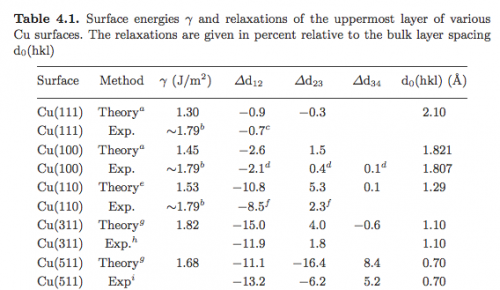exercises:2014_ethz_mmm:surface_cu
Surface energies of Copper high-symmetry surfaces
In this exercise we will compute the surface energies of Cu using the EAM potential. As a reference, we report the table from the Gross book:
- Copy the files from from the wiki: exercise_3.1.zip (all inputs are commented) into a new directory
- Use the batch run_cp2k_lattice to run a chain of simulations on a Cu bulk system. From the output lat.out check the lattice constant corresponding to minimum cohesive energy PER ATOM (divide by the number of particles, find it out!), you will need it later
- Run the optimizations 100.inp, 110.inp, 111.inp —- look at the corresponding initial coordinate files 100.xyz, 110.xyz, 111.xyz.
- In vmd, you can also open a console, and give the command pbc set { a b c 90 90 90 } where a, b, c can be extracted from the cp2k input file. Then you can make several periodic copies for visualization.
- Compute the three surface energies: you need to compute the area, subtract bulk contribution, take care of the units.
- In the class we will learn how to compute the Wulff crystal from these three numbers.
- Basically, you should edit the input file “DP”, replacing the column beginning with “PUT_HERE_THE_XXX_SURFACE_ENERGY” with quantities that are proportional to the three surface free energies (see Wulff theorem). Note that for the {100} and {110} surfaces you need to edit TWO lines each, since the z direction is treated differently in this program.
- At this point, you run the program with the command ./sowos.v02.00.02.x
- There will be many output files. Important are
- * the atomistic model out.atomistic-inside-gnuplot.xyz which will contain many atoms if you chose a proportionality constant in the file DP which is too large. If you appropriately modify it (how?) you can have a xyz file to be opened in vmd.
- * the out.plot-gnuplot.plt file. If you launch gnuplot, then “load “out.plot-gnuplot.plt” a plot of the crystal will be shown. To have it more or less to scale in all directions: set xrange [-80:80];set yrange [-80:80]; set view equal xyz; replot
- * you can rotate with the mouse!
Assignment: use the cluster generated with SOWOS as an input configuration for a cluster optimization with cp2k. Comment on the final geometry. BEWARE OF THE CELL! It is not a periodic system!
documentation on SOWOS can be found at the web site of Daniele Scopece
exercises/2014_ethz_mmm/surface_cu.txt · Last modified: by 127.0.0.1

